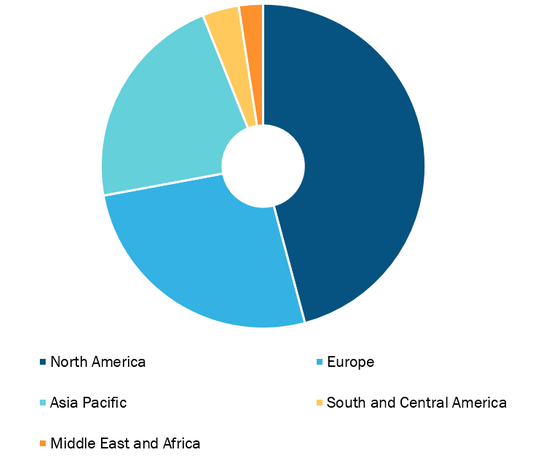According to our latest study on "Medical Imaging Informatics Market Forecast to 2028 – COVID-19 Impact and Global Analysis – Type (Digital Radiography, Ultrasound, MRI, CT, Nuclear Imaging, and Mammography), Application (Hospitals, Ambulatory Healthcare Settings, Diagnostic and Imaging Centers, and Others), and Component (Software, Hardware, and Services)," the market is expected to grow from US$ 3,671.72 million in 2021 to US$ 5,175.39 million by 2028; it is estimated to grow at a CAGR of 5.0% from 2021 to 2028. The report highlights the key factors driving the market and prominent players with their developments. The medical imaging informatics market growth is attributed to increasing number of medical imaging procedures and surging geriatric population. However, the lack of expertise to operate medical imaging informatics systems is expected to restrict the market growth during the forecast period.
The COVID-19 pandemic significantly impacted the operations of a variety of industries. The pandemic is predicted to have a short-term impact on the medical imaging informatics market. Countries falling under North America were highly impacted by COVID-19 in the initial stages, i.e., during the first wave, which also affected the medical imaging informatics market. As per the Society of Nuclear Medicine and Molecular Imaging (SNMMI), nearly 80% of respondents saw 50–75% declines in nuclear medicine imaging procedures. In the US, due to an increasing number of infected patients and lethal COVID-19 variants, the diagnostic and imaging activities had come to an end for an extended period during the pandemic. Thus, the overall diagnosis of chronic diseases with medical imaging informatics was delayed, which hampered the market. Therefore, COVID-19 has a potential economic impact on most sectors, including oncology procedures. The pandemic hindered cancer diagnosis and surgeries and is likely to impact the market negatively. The COVID-19 pandemic also compromised the hospital operations as social distancing parameters and treatment of COVID-19 patients were given priority. Moreover, due to restrictions and lockdowns, people's visits to hospitals and diagnostic centers declined significantly, affecting the demand for medical imaging modalities and informatics.
However, people's lives are returning to normal now with the improving COVID-19 situation across the globe. Patients are visiting hospitals and diagnostic centers for their routine checkups and treatment follow-up for chronic disorders such as cancer and cardiovascular disorders. This is expected to fuel the demand for medical imaging informatics in the near future.
Thus, the COVID-19 pandemic severely impacted the medical imaging informatics market; however, the market is expected to experience growth opportunities in the coming years.
Based on type, the medical imaging informatics market is segmented into digital radiography, ultrasound, MRI, CT, nuclear imaging, and mammography. The ultrasound segment held the largest share of the market in 2021. However, the mammography segment is anticipated to register the highest CAGR of 5.7% during the forecast period. Mammography is a dedicated radiographic technique that uses a low-dose x-ray system to see inside the breasts. A mammography exam, called a mammogram, aids in detecting and diagnosing breast diseases in women. Three recent advances in mammography include digital mammography, computer-aided detection, and breast tomosynthesis. Breast tomosynthesis, also called three-dimensional (3-D) mammography and digital breast tomosynthesis (DBT), is an advanced form of breast imaging where multiple images of the breast from different angles are captured and reconstructed ("synthesized") into a three-dimensional image set. Large population studies have shown that screening with breast tomosynthesis results in improved breast cancer detection rates and fewer call-back instances where women are called back from screening for additional testing because of a potentially abnormal finding.
Moreover, the major factors responsible for the growth of the mammography segment include the growing prevalence of breast cancer and technological advancements in breast imaging. According to the Centers for Disease Control and Prevention (CDC) reports 2018, breast cancer is one of the most common cancers among women, irrespective of race or ethnicity. It is also the third-most-common cause of cancer deaths among American Indian/Alaska Native women.
Agfa-Gevaert Group; Carestream Health; ESAOTE SPA; General Electric; Koninklijke Philips N.V.; Siemens Healthcare GmbH; Hologic, Inc.; Konica Minolta, Inc.; Shenzen Mindray Bio-Medical Electronics Co., Ltd.; and Fujifilm Holdings Corporation are among the leading companies in the medical imaging informatics market.
Medical Imaging Informatics Market, by Region, 2021 (%)

Medical Imaging Informatics Market Forecast and Size by 2031
Download Free Sample
Medical Imaging Informatics Market Size and Forecast (2021 - 2031), Global and Regional Share, Trend, and Growth Opportunity Analysis Report Coverage: By Type (Digital Radiography, Ultrasound, MRI, CT, Nuclear Imaging, Mammography); Application (Hospital, Ambulatory Healthcare Settings, Diagnostic and Imaging Centers, Others), Component (Software, Hardware, Services), and Geography
Medical Imaging Informatics Market Forecast and Size by 2031
Download Free SampleMedical Imaging Informatics Market Size and Forecast (2021 - 2031), Global and Regional Share, Trend, and Growth Opportunity Analysis Report Coverage: By Type (Digital Radiography, Ultrasound, MRI, CT, Nuclear Imaging, Mammography); Application (Hospital, Ambulatory Healthcare Settings, Diagnostic and Imaging Centers, Others), Component (Software, Hardware, Services), and Geography
The report segments the medical imaging informatics market as follows:
The medical imaging informatics market is segmented based on type, application, component, and geography. Based on type, the market is segmented into digital radiography, ultrasound, MRI, CT, nuclear imaging, and mammography. In terms of application, the medical imaging informatics market is divided into hospitals, ambulatory healthcare settings, diagnostic and imaging centers, and others. Based on component, the medical imaging informatics market is segmented into software, hardware, and services. By geography, the medical imaging informatics market is segmented into North America (the US, Canada, and Mexico), Europe (the UK, Germany, France, Italy, Spain, and the Rest of Europe), Asia Pacific (China, Japan, India, Australia, South Korea, and the Rest of Asia Pacific), the Middle East & Africa (the UAE, Saudi Arabia, South Africa, and the Rest of the Middle East & Africa), and South & Central America (Brazil, Argentina, and the Rest of South & Central America).
Contact Us
Phone: +1-646-491-9876
Email Id: sales@theinsightpartners.com